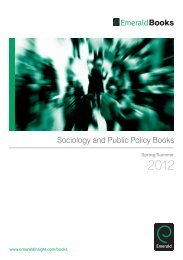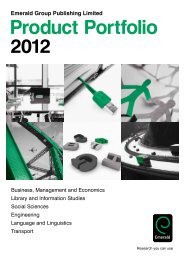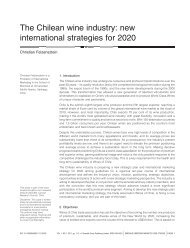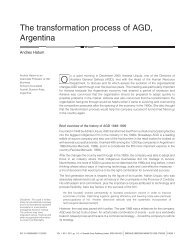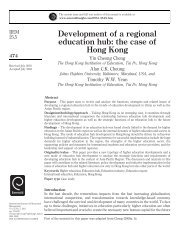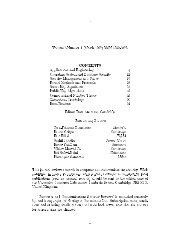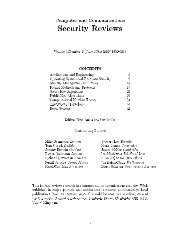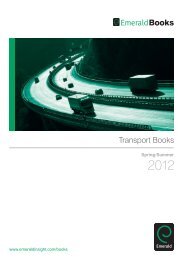Facilitating transdisciplinary sustainable development research ...
Facilitating transdisciplinary sustainable development research ...
Facilitating transdisciplinary sustainable development research ...
You also want an ePaper? Increase the reach of your titles
YUMPU automatically turns print PDFs into web optimized ePapers that Google loves.
IJSHE<br />
11,1<br />
38<br />
domestically and internationally around critical public policy issues, in particular,<br />
<strong>sustainable</strong> <strong>development</strong>. The large questions that must be addressed: land use patterns,<br />
large-scale transportation and sprawl, transition strategies to more <strong>sustainable</strong><br />
infrastructure, reconciliation between rural, small and large urban centres will only be<br />
met through assembling diverse teams of the best minds locally and globally.<br />
This paper describes the outcomes of a one year <strong>research</strong> project in which the<br />
authors explored the role that electronic communications technologies can play in the<br />
successful utilization of <strong>transdisciplinary</strong> teams.<br />
Electronic communications technology is playing a growing role in mitigating the<br />
time, travel and funding stresses of assembling a <strong>transdisciplinary</strong> team, but<br />
these technologies raise their own set of questions. Though e-mail is ubiquitous in the<br />
academy, online document crafting, the online <strong>development</strong> of <strong>research</strong> programs<br />
and outcomes, and online dialogue are still very much developing techniques within<br />
the <strong>research</strong> community. One of the key questions for an interdisciplinary or<br />
<strong>transdisciplinary</strong> team is “how to communicate” (McNeill, 1999), and it is important to<br />
assess various interpersonal and inter-organizational processes that either facilitate or<br />
hinder a group’s effort to produce deliverables (Stokols, 2006).<br />
Transdisciplinary <strong>research</strong> and <strong>sustainable</strong> <strong>development</strong><br />
Transdisciplinary <strong>research</strong> is common in the area of environmental <strong>research</strong> and<br />
particularly critical in the domain of <strong>sustainable</strong> <strong>development</strong> (Robinson, 2008). Defined<br />
in the early 1970s by Jantsch (1972) as taking disciplinary knowledge and making it<br />
useful for socially relevant issues, <strong>transdisciplinary</strong> study has also been described as an<br />
approach to problem solving suited to settings where disciplinary modes prove<br />
inadequate (Century, 1999), a process or activity that produces, integrates and manages<br />
knowledge in technical, social and scientific areas (Thompson Klein, 2004).<br />
Transdisciplinary <strong>research</strong> maintains a focus on application; much <strong>transdisciplinary</strong><br />
<strong>research</strong> is associated with a notion of creating change, the desire to contribute to<br />
solutions (Wickson et al., 2006), and the production of useful knowledge. The<br />
characteristic features of transdisciplinarity include problem focus (<strong>research</strong> originates<br />
from and is contextualized in “real-world” problems), synthetic methodological practice<br />
(the <strong>research</strong> involves iterative, reflective processes that are responsive to the particular<br />
questions, settings and <strong>research</strong> groupings) and collaboration (between <strong>research</strong>ers,<br />
practitioners and external actors; Russell et al., 2008).<br />
If <strong>transdisciplinary</strong> <strong>research</strong> is a critical necessity of <strong>sustainable</strong> <strong>development</strong><br />
<strong>research</strong>, there are nevertheless several barriers to successful <strong>transdisciplinary</strong><br />
<strong>research</strong> identified in the literature. As a practice defined by collaboration (Wickson<br />
et al., 2006) in order to create coherent knowledge (Ramadier, 2004), transdisciplinarity<br />
requires that a diverse coalition work together.<br />
Online collaboration, capturing the spaces in between<br />
The collaborative dialogue central to <strong>transdisciplinary</strong> <strong>research</strong> can be very rich,<br />
creating the “mutualized chaos” that helps participants overcome assumptions<br />
(Hammond and Sanders, 2002) and create consensus. In order to mitigate expense<br />
and reduce the time requirements of collaboration, the principal investigator has<br />
explored internet communication technology over a seven-year period (Dale, 2005;<br />
Dale and Naylor, 2005; Dale and Newman, 2006a, b). The authors are not alone in



